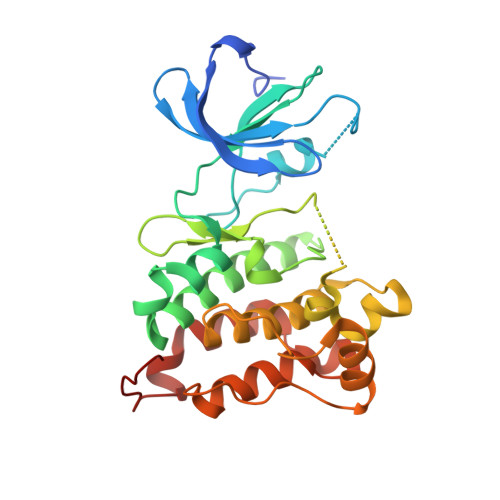Targeting Drug Resistance in EGFR with Covalent Inhibitors: A Structure-Based Design Approach.
Engel, J., Richters, A., Getlik, M., Tomassi, S., Keul, M., Termathe, M., Lategahn, J., Becker, C., Mayer-Wrangowski, S., Grutter, C., Uhlenbrock, N., Krull, J., Schaumann, N., Eppmann, S., Kibies, P., Hoffgaard, F., Heil, J., Menninger, S., Ortiz-Cuaran, S., Heuckmann, J.M., Tinnefeld, V., Zahedi, R.P., Sos, M.L., Schultz-Fademrecht, C., Thomas, R.K., Kast, S.M., Rauh, D.(2015) J Med Chem 58: 6844-6863
- PubMed: 26275028
- DOI: https://doi.org/10.1021/acs.jmedchem.5b01082
- Primary Citation of Related Structures:
5D10, 5D11, 5D12 - PubMed Abstract:
Receptor tyrosine kinases represent one of the prime targets in cancer therapy, as the dysregulation of these elementary transducers of extracellular signals, like the epidermal growth factor receptor (EGFR), contributes to the onset of cancer, such as non-small cell lung cancer (NSCLC). Strong efforts were directed to the development of irreversible inhibitors and led to compound CO-1686, which takes advantage of increased residence time at EGFR by alkylating Cys797 and thereby preventing toxic effects. Here, we present a structure-based approach, rationalized by subsequent computational analysis of conformational ligand ensembles in solution, to design novel and irreversible EGFR inhibitors based on a screening hit that was identified in a phenotype screen of 80 NSCLC cell lines against approximately 1500 compounds. Using protein X-ray crystallography, we deciphered the binding mode in engineered cSrc (T338M/S345C), a validated model system for EGFR-T790M, which constituted the basis for further rational design approaches. Chemical synthesis led to further compound collections that revealed increased biochemical potency and, in part, selectivity toward mutated (L858R and L858R/T790M) vs nonmutated EGFR. Further cell-based and kinetic studies were performed to substantiate our initial findings. Utilizing proteolytic digestion and nano-LC-MS/MS analysis, we confirmed the alkylation of Cys797.
Organizational Affiliation:
Department of Chemistry and Chemical Biology, TU Dortmund University , Otto-Hahn-Straße 6, D-44227 Dortmund, Germany.
















